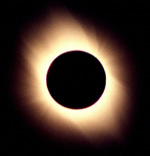home | facts about the moon | the moon's effect on earth | man's relationship with the moon | contact us
The gravitational attraction that the Moon exerts on Earth is the cause of tides in the sea. The tidal flow period is synchronized to the Moon's orbit around Earth, but the phase isn't. The tidal bulges on Earth, caused by the Moon's gravity, are carried ahead of the apparent position of the Moon by the Earth's rotation, in part because of the friction of the water as it slides over the ocean bottom and into or out of bays and estuaries. As a result, some of the Earth's rotational momentum is gradually being transferred to the Moon's orbital momentum, resulting in the Moon slowly receding from Earth at the rate of approximately 38 mm per year. At the same time the Earth's rotation is gradually slowing, the Earth's day thus lengthens by about 15 µs every year.

The angular diameters of the Moon and the Sun as seen from Earth overlap in their variation, so that both total and annular solar eclipses are possible. In a total eclipse, the Moon completely covers the disc of the Sun and the solar corona becomes visible to the naked eye. Since the distance between the Moon and the Earth is very slightly increasing over time, the angular diameter of the Moon is decreasing. This means that several million years ago the Moon always completely covered the Sun on solar eclipses so that no annular eclipses occurred. Likewise, in several million years the Moon will no longer cover the Sun completely and no total eclipses will occur. Eclipses happen only if Sun, Earth and Moon are lined up. Solar eclipses can only occur at new moon; lunar eclipses can only occur at full moon.
The Moon is most clear at night, but can sometimes be seen during the day. The Moon (and also the Sun) appear larger when close to the horizon. This is a purely psychological effect. The angular diameter of the Moon from Earth is about one half of one degree. During the brightest full moons, the Moon can have an apparent magnitude (the amount of light received from the object) of about −12.6. For comparison, the Sun has an apparent magnitude of −26.8.
For any location on Earth, the highest altitude of the Moon on a day varies between the same limits as the Sun, and depends on season and lunar phase. For example, in winter the Moon comes highest when it is full, and the full moon comes highest in winter.
Like the Sun, the Moon can also give rise to an optical effect known as a halo (an optical phenomenon that appears near or around a light source).
The event known as a blue moon is related to the western calendar system. A blue moon is the second of two full moons to occur in the same calendar month. Blue moons occur infrequently (thus the saying once in a blue moon to denote a rare event), because the length of the calendar month in this system is close to the length of the period of the moon's phases. They are not impossible, because every month except February is longer than this period by 1 or 2 days. Blue moons occur every 2.72 years. The next blue moons will be on June 30, 2007; and December 31, 2009.*
*Visibly blue moons are rare events. They can be caused by smoke or dust particles in the atmosphere, such as happened after forest fires in Sweden in 1950 and Canada in 1951 and, notably, after the eruption of Krakatoa in 1883, which caused blue moons for nearly two years.